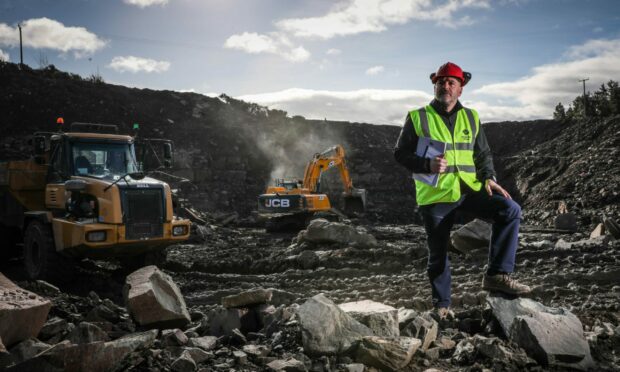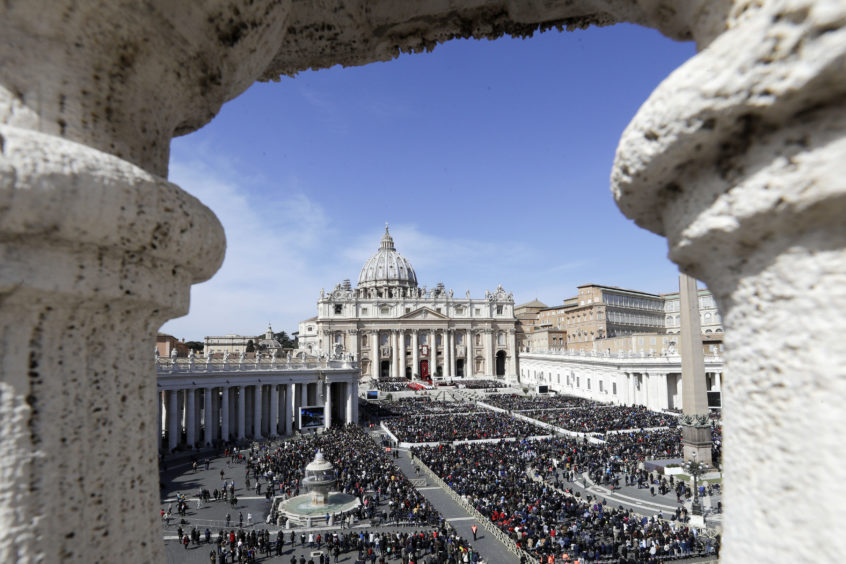Cologne Cathedral, Germany’s premier tourist trap and The Vatican, the stronghold of Catholicism, perhaps don’t have much in common on the surface. But peek underneath and you’ll find a common factor, Angus sandstone.
It has been used in world renowned bastions of national pride for centuries but now its producers want to raise its own notoriety.
Denfind Stone are looking to re-establish their premier resource as an international building essential.
The firm, located in Monikie, has recently secured a long-term future with a fresh 50-year licence so are now appealing for information to build a clearer picture of the material’s history.
Sandstone is a natural product that takes 400 million years to develop and is known for its unique colour palette.
These multitudes of textures and tones are caused by iron oxides and manganese oxides combining to create ornamental desirability.
Angus sandstone has been used in multiple iconic Scottish structures, including Falkland Palace, Edinburgh Castle’s Great Hall and Gleneagles Hotel.
It has also been exported all over the world.
Denfind Stone history
Once at the heart of the thriving Angus sandstone industry, the Pitairlie Quarry lay barren for 89 years after halting production in 1915.
The demand for sandstone dried up following the outbreak of war across Europe as many export markets ceased trading.
In 2004 Brian and Alison Binnie decided to resurrect the institution after noticing the potential the abandoned facility had to quell the growing desire for natural building materials. And thus Denfind Stone was born.
Owner and director Brian Binnie now wants to go one step further and re-establish Angus sandstone’s global reputation.
He said: “Angus hasn’t fully recognised the impact of this industry globally, there is a lack of awareness and this global industry should be celebrated.
“The history records we have come across state they were transporting 150 tons to the harbour every day.
“From Arbroath they would go to Leith or Glasgow before going off to Australia, mainland Europe and North or South America.
“It is all very relevant to us, having received planning consent, we are now supplying sandstone in significant volumes again following in the footsteps of these quarriers.
“The fascination for us is to piece together where that stone went.”
Denfind takes rock from underground and produces Arbroath Paving, walling stone and Carmyllie Slates.
The quarry at Pitairlie is the last remaining one producing Angus sandstone for building materials.
While Denfind itself has only been back in production for almost 20 years, sandstone has been used in construction for centuries.
Appeal for information
Denfind Stone are keen to promote Angus sandstone as an international building resource once again.
But to do this they are on the hunt for information on where it has been used and by whom.
Without doubt the flagship for international recognition is the use of Angus sandstone in the construction of The White House.
There is no direct proof, but anecdotal evidence suggests it was used in the construction of what has been the home of the US president since 1800, when John Adams became the first resident of the neoclassical designed house, it is one of the most recognisable buildings in the world.
Standing alongside that is The Vatican. Historic environment Scotland (HES) have confirmed the usage of Angus sandstone throughout the construction of the impressive roof of the papal residence.
The nature of sandstone made it popular for roof construction because it could be moulded to suit the design.
As well as The White House and The Vatican it is thought to have been used on Cologne Cathedral.
The cathedral, located in the North Rhine-Westphalia region, is home to the Archbishop of Cologne and houses the shrine of the three wise men.
It is the most-visited tourist destination in Germany, attracting an average of 20,000 visitors per day.
Brian said: “HES are working with us on numerous projects and are looking to do a survey on Angus sandstone in order to piece together where the stone went.
“You can identify it quite readily, it is distinctive in its look.
“We have little snippets but are fascinated to see if anyone has any local, historical records.”
Angus abroad…
There is no hard evidence as to how Angus sandstone became renowned the world over.
Its pliable nature and sustainability makes it the perfect resource for restoring or renovating buildings of any age.
Brian wonders: “In the days before social media, how did people in Cologne or California get to recognise that Angus sandstone was the paving stone to go for?
“Was it the efficiency of the operation that lowered the cost or was it something else?”
One theory does stand above the rest, however: the well-respected reputation of the Scottish stonemason.
“We know the Scots were great travellers. We know that Scots stonemasons were held in high regard.
“It would certainly go some way to explain how Angus sandstone became so widely desired.
“We would love to see any records of masons travelling for work. And if this stone was heading in the same direction.”
The future of Angus sandstone
It was a cornerstone of the country’s economy and now Denfind are keen to encourage the increased use of sandstone within construction.
“For Angus the achievement that these guys did in the 19th Century is outstanding and we want to carry that with us.
“The innovation element from then has continued and we are now able to facilitate the materials that come from the ground that aren’t suitable for paving.
“We have become very efficient in quarrying and can utilise even the waste that the 19th Century quarriers produced.”
With more than 500,000 tonnes of undisturbed natural sandstone waiting to be quarried Denfind will continue to supply the finest of stone to the finest of buildings for decades to come.
Those with information regarding Angus sandstone can get in touch with Denfind Stone here.

















Conversation